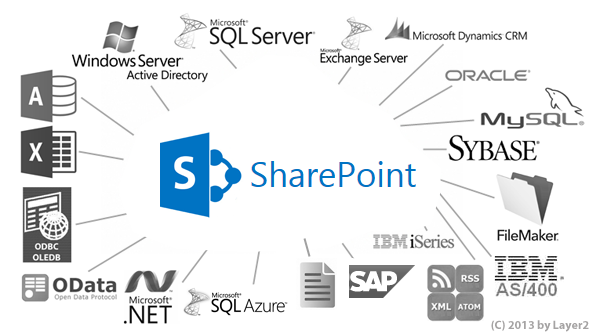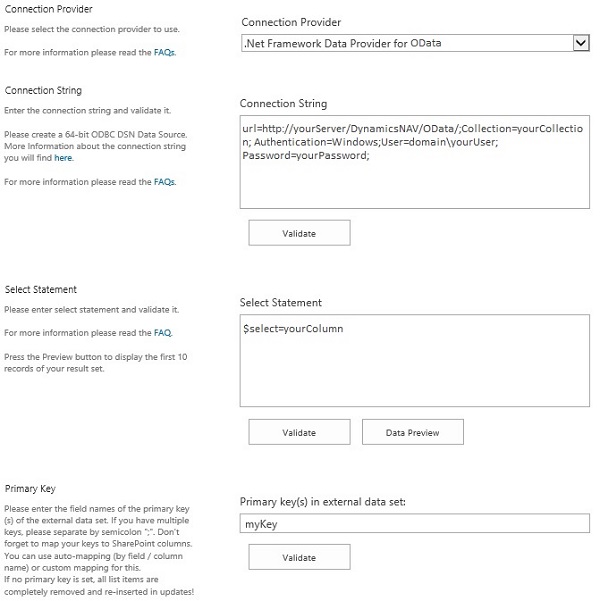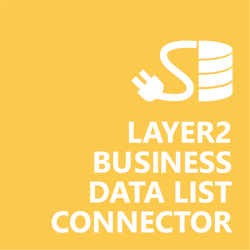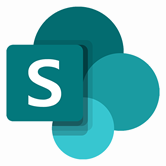Keep your Sharepoint in sync. Download and try today.
Microsoft Dynamics NAV & SharePoint Integration
Microsoft Dynamics NAV data can be integrated codeless with native SharePoint lists using the Layer2 Business Data List Connector. Please take a look here for more supported systems and applications. In case you are looking for Online data integration, you will find the right tool here.

Benefits of Microsoft Dynamics NAV Integration in SharePoint
- Very easy to setup in a few minutes: Create a SharePoint list, click "Connect to external data source" in the list settings, select the data provider, enter connection settings and data query as shown below. That's it.
- No installation or changes on the Microsoft Dynamics NAV side: No programming, no additional tools.
- Connected data always up-to-date: The connected data updates automatically in background (via SharePoint Timer Job), or alternatively, on-demand (Action Menu / Ribbon Button, URL, via workflow, API).
- One-way and optional two-way connection: You can write-back the changes made in SharePoint to the Dynamics NAV data source automatically with full CRUD (Create / Update / Delete) functionality. The SharePoint list can act as a full-featured front-end for Dynamics NAV.
- Well-known BCS "external list" issues and limitations are completely solved: ALL list features are to you. Views, sorting and grouping, filters, calculated fields, search, managed metadata. Lookups, additional columns and attachments can be created as normal. All kind of lists can be used, e.g. contacts, tasks, calendar, or custom lists. You can take external data offline via Outlook.
- Workflows and notifications on Dynamics NAV data change: List workflows and change notifications per RSS or email can be used to take business actions in SharePoint, when external Dynamics data records are changed.
- You can save Dynamics NAV licenses: Users are working with native SharePoint lists as a "data cache". No Dynamics NAV licenses are required for SharePoint users.
- Application logging, reporting, and notifications: A SharePoint list is used to store settings and log information. SharePoint item versioning and workflows can be used to manage reporting and notifications. Direct notification per email in case of errors is supported as well.
- Highest Security, best performance, easy to maintain: SharePoint Secure Store can be used to store security relevant configuration information safely in one central place. Users are working with the SharePoint lists as an external data cache with highest security and performance.
- 100+ more external systems supported: Layer2 Data Providers included (e.g. for SharePoint/Office 365, Exchange, Dynamics, OData, XML/RSS, SOAP), vendor specific data providers can be used (e.g. SQL Server Oracle, mySQL etc.), 3rd party data providers also supported, e.g. for ERP/CRMs, Facebook or Twitter. See here for supported systems and applications.
Microsoft Dynamics NAV SharePoint Specific Configuration Settings
In the Layer2 Business Data List Connector the data source must be configured as follows to connect to Microsoft Dynamics NAV.

Figure 1: Sample connection configuration to connect SharePoint to Microsoft Dynamics NAV via BDLC.
Please note the following specific settings.
- Select the OData Data Provider to connect. The provider is part of the Layer2 Business Data List Connector ADO.NET provider package and should be already installed. You will find an OData Provider specification here.
- You can use a connection string like this to
connect:
url=http://myNAVServer:7048/DynamicsNAV80/OData/; Collection=Customers; Authentication=Windows; User=domain\username; Password=myPassword - Several different authentication methods are generally supported. See provider specification linked above for more.
- You can make use of OData to query your data as supported by the data provider and source system. For more information about supported queries, see Microsoft Dynamics NAV OData specification.
- You can map your data fields to specific external fields in the Layer2 Cloud Connector. Please take care about data types (simple type conversions are supported).
- Please enter an appropriate primary key (column with unique values), depending on query (use the data preview to find an appropriate field for this).
- You can use the connection for uni- or bi-directional synchronization. In case of inserts (full CRUD) via external systems, please take care of the primary key.
- No installation or changes are required at the Dynamics CRM data source or data destination.
- No programming required for setup a connection and sync.
- No need to open your local network for access from outside.
Dynamics NAV to SharePoint Connection Details
Provider:
.Net Framework Data Provider for OData
Connection string sample:
url=http://myNAVServer:7048/DynamicsNAV80/OData/; Collection=Customers; Authentication=Windows; User=domain\username; Password=myPassword
Select Statement sample:
$select=Customer_No
Dynamics NAV to SharePoint Integration Known Issues & Workarounds
The Dynamics NAV integration with SharePoint via Layer2 Business Data List Connector has the following known issues and workarounds:
- It may be required that a simple web service be published through the NAV Administration tool to expose the data you want in the OData service. See the Dynamics NAV OData specification for more information.
- Note that NAV 2013 supports read-only. NAV 2013 R2, NAV 2015 and NAV 2017 supports both read and write functionality via OData.
Ready to go next steps?





